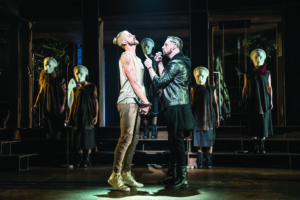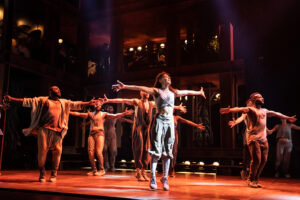By Shari Goldstein Stern
“Jesus Christ Superstar,” the rock opera, took command of the Music Hall stage at Fair Park so powerfully at its opening last week, you can still hear stanzas of “Jesus Christ, Jesus Christ, who are you, what have you sacrificed?” over Keurigs in coffee-break rooms across North Texas.
Lest there be confusion: Formerly known as the Dallas Summer Musicals (DSM) for decades, the company’s name changed recently to Broadway Dallas, reflecting the more current offerings of nationally touring Broadway shows.

Photos by Matthew Murphy
Fifty years ago, playwright Andrew Lloyd Webber and composer and lyricist Tim Rice first told their artists’ account of history when “Jesus Christ Superstar” opened at London’s Palace Theatre on August 9, 1972. A growing genre of live musical theater, the rock opera solidified its international space as an exciting, innovative form of theater. On the heels of the 1960s “Tommy,” by The Who and “Hair,” the “sung-through” theater form, mimicking opera to an extent, caught on, only to grow in popularity throughout the years since.
Last Tuesday night, patrons were mesmerized by this newest rendition of the multiple award winning phenomena. Webber, who also penned “Cats” and “Phantom of the Opera,” for starters, created a historical sensation with this provocative rock opera.
It takes too many superlatives to report on this production. At the risk of overusing the term “spectacular,” let’s just agree that after experiencing the show, the music, orchestration, vocals, choreography and dance create an unforgettable feast for the senses. Add innovative lighting and rustic, original sets, and Broadway Dallas’ first show introducing its new name is, in a word, “spectacular.”

Costumes don’t look like costumes at all, but muted tones of drapey fabrics comprise current looks in the wardrobe. Flowing pants and tops with plenty of bare tummy look comfortable. They lend themselves to the unique, breathtaking choreography in a series of production numbers so mesmerizing, they should never end. The dramatic lighting starts with brightly lit crucifixes strewn around the stage. They were almost blinding, but that didn’t matter. They were breathtaking. That also describes the variety of stage lights and spotlights that enriched staging and added the illusion of passion.
Almost indescribably, the sets are both rustic and innovative. Every square foot of the stage’s real estate is utilized to its fullest. At one point, an off-the-chart dance routine is performed onstage first, and then in one of the set’s small “cubicles.” The non-stop, athletic, strong, vociferous, dancer gyrated while banging her head and every other extremity for what seemed like 20-minute intervals. It was hard to take the eyes off her powerful, rhythmic physicality.
Also in a cubicle, three singers dance The Supremes-style while belting out “Jesus Christ, Superstar” along with the entire ensemble in a jaw-dropping production number of the song. A nine-piece orchestra, directed by Shawn Gough and Matthew Croft, was perched atop the set, putting out enough clear sounds and electronics to fill up the theater.
Some cast members make entrances and exits on an elevated, movable ramp. It doubles as the horrific site of the crucifixion in slow motion. First is an intense, hard on the senses depiction of “Trial by Pilate/39 Lashes,” with gold glitter representing bloody pain. During the placement of his thorny crown Jesus makes ethereal mutterings of his suffering. Those two scenes feel like they last a month, as they are so lingering for dramatic effect. It works.
As Caiaphas, Alvin Crawford puts his rich, smooth as silk baritone to work. His buttery tones coupled with his enormous, searching brown eyes are a wonder. He could keep an audience mesmerized on his own. As Mary, Jenna Rubaii sings the way angels might sing. This talented actor’s vocals for “I don’t know how to love him” wrap a spell around the audience. Both actors bring uncanny passion, which resonates in their vocals.
Most know the story: Judas is unhappy with the direction in which Jesus is steering his disciples, and so he betrays him. In “Jesus Christ Superstar,” contemporary attitudes, sensibilities and slang have their place the rock opera’s lyrics, and ironic allusions to modern life are present throughout the depiction of political events.
Omar Lopez-Cepero as Judas wears a leather jacket over a hoodie when he holds a microphone to deliver solos. His wardrobe is unexpected. His voice is heavenly.
Jesus himself is often wearing current clothing and singing into a hand mic. Aaron LaVigne’s performance as Christ is a masterwork. His passion feels authentic, and his vocals are impeccable.
For tickets, visit the website broadwaydallas.org.
